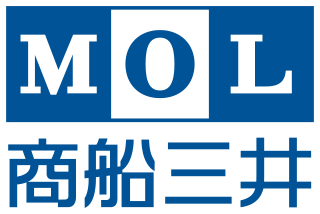
Mitsui O.S.K. Lines is a Japanese transport company headquartered in Toranomon, Minato, Tokyo, Japan. It is one of the largest shipping companies in the world.

A cargo ship or freighter is a merchant ship that carries cargo, goods, and materials from one port to another. Thousands of cargo carriers ply the world's seas and oceans each year, handling the bulk of international trade. Cargo ships are usually specially designed for the task, often being equipped with cranes and other mechanisms to load and unload, and come in all sizes. Today, they are almost always built of welded steel, and with some exceptions generally have a life expectancy of 25 to 30 years before being scrapped.

A bulk carrier or bulker is a merchant ship specially designed to transport unpackaged bulk cargo—such as grain, coal, ore, steel coils, and cement—in its cargo holds. Since the first specialized bulk carrier was built in 1852, economic forces have led to increased size and sophistication of these ships. Today's bulk carriers are specially designed to maximize capacity, safety, efficiency, and durability.
Odense Steel Shipyard was a Danish shipyard company located in Odense. It was best known for building container ships for its parent group, A.P. Moller – Maersk Group, including the Mærsk E class in 2006 which at the time were the biggest container ships in the world. The global financial crisis led to Maersk announcing its closure in 2009 and the last new ship was delivered in January 2012.

Iran Shipbuilding & Offshore Industries Complex Co (ISOICO) is an Iranian ship yard, located in the Persian Gulf, Strait of Hormuz, active as shipbuilder and ship-repairer of different types of vessels and offshore structures. ISOICO is a subsidiary of IDRO.

Cochin Shipyard Ltd (CSL) is the largest shipbuilding and maintenance facility in India. It is part of a line of maritime-related facilities in the port-city of Kochi, in the state of Kerala, India. Of the services provided by the shipyard are building platform supply vessels and double-hulled oil tankers. It built the first indigenous aircraft carrier for the Indian Navy, the INS Vikrant. The company has Miniratna status.

Garden Reach Shipbuilders & Engineers Ltd, abbreviated as GRSE, is one of India's leading shipyards, located in Kolkata. It builds and repairs commercial and naval vessels. GRSE also exports the ships that the company builds.

Philly Shipyard, formerly Aker Philadelphia Shipyard, is a commercial shipyard located in Philadelphia, Pennsylvania, United States on part of the site of the Philadelphia Naval Shipyard. The commercial yard began after the United States Navy had ended most of its operations at the site.

MISC Berhad was incorporated in 1968 as Malaysia International Shipping Corporation Berhad and is the leading international shipping line of Malaysia. In September 2005, Malaysia International Shipping Corporation Berhad adopted its present corporate identity and changed its name to MISC Berhad. Its main shareholder is Petroliam Nasional Berhad (Petronas), the national oil conglomerate of Malaysia. The principal business of the corporation consist of ship owning, ship operating, other shipping related activities, owning and operating of offshore floating facilities as well as marine repair, marine conversion and engineering and construction works. With a fleet of more than 120 vessels and a combined tonnage of more than 13,000,000 DWT.

Uljanik was a shipbuilding company in Pula, Croatia.
A/S J. Ludwig Mowinckels Rederi is a Bergen-based shipping company that operates eight tankers with six newbuildings. The company is privately owned and has divided ownership between one foundation and the Mowinckel family through the founder's J. Ludwig Mowinckel's wife Julie Mowinckel's will and testament - still after 30 years waiting to be settled. The foundation "Magda Muller Mowincels Legat" was set up in 1985 by Magda Mowinckel - the daughter of the founder - and aims to protect and serve for the company's economy and existence.
Port Weller Dry Docks was a shipbuilder on the Welland Canal at the Lake Ontario entrance. The shipbuilder was founded in 1946 and the site was initially owned by the Government of Canada for storage purchases. The shipyard expanded to include ship repair, and reconstruction work. In 1956, the drydock was sold to the Upper Lakes Shipping Company, which began the construction of vessels at the site. The shipyard twice went insolvent, most recently in 2015. Port Weller Dry Docks was used to build, refit and repair cargo vessels.

The Compagnie Maritime Belge (CMB) is one of the oldest Antwerp ship-owners. It is controlled by the Saverys family who also own major stakes in the Exmar and Euronav groups.

The Karachi Shipyard & Engineering Works Limited is a major defence contractor and shipbuilding company situated in the West Wharf in Karachi, Sindh in Pakistan.
Oshima Shipbuilding Co., Ltd. is a privately held Japanese shipbuilding company. The company was founded on February 7, 1973, and began operations in June 1974. It is a joint venture between Sumitomo Corporation, Sumitomo Heavy Industries, and the Daizo Corporation.

Constanța Shipyard is the largest shipyard in Romania and one of the largest in Europe having a market share of 20% in the Black Sea basin. The shipyard has two drydocks, one used for the construction of ships up to 150,000 tonnes deadweight (DWT), and the second one used for the construction of ships up to 250,000 DWT, and two floating docks with a capacity of 8,000 tonnes and 15,000 tonnes.
HD Hyundai Mipo is one of the largest shipbuilding companies with the world's largest share (50%) in PC segment. Since the 1980s, more than 10,000 ships were repaired and converted until 2005 and 400 newly ordered ships were delivered until 2009. It delivers about 70 new ships in a year. The delivered amount is over 1 million compensated gross tonnage (CGT) in a year (2007), making it 4th in the world. Its product mix is shipbuilding (96.4%) and conversion and repair (3.6%). It is a member of HD Hyundai and was listed on KOSPI in 1983.

Excel Maritime Carriers Ltd. is a shipping company specializing in the transport of dry bulk cargo such as iron ore, coal and grains, as well as bauxite, fertilizers and steel products. As of May 2009, it is the largest bulk carrier by DWT of any U.S.-listed company. Approximately one-third of all seaborne trade is dry bulk related. Excel Maritime was a component of the NYSE Composite Index and the PHLX Marine Shipping Index. The stock has been de-listed from the exchanges as per their rules of listing

London & Overseas Freighters Ltd. (LOF) was an ocean-going merchant shipping company that for most of its history was based in the United Kingdom.

Hindustan Shipyard Limited (HSL) is a shipyard located in Visakhapatnam on the east coast of India.
















